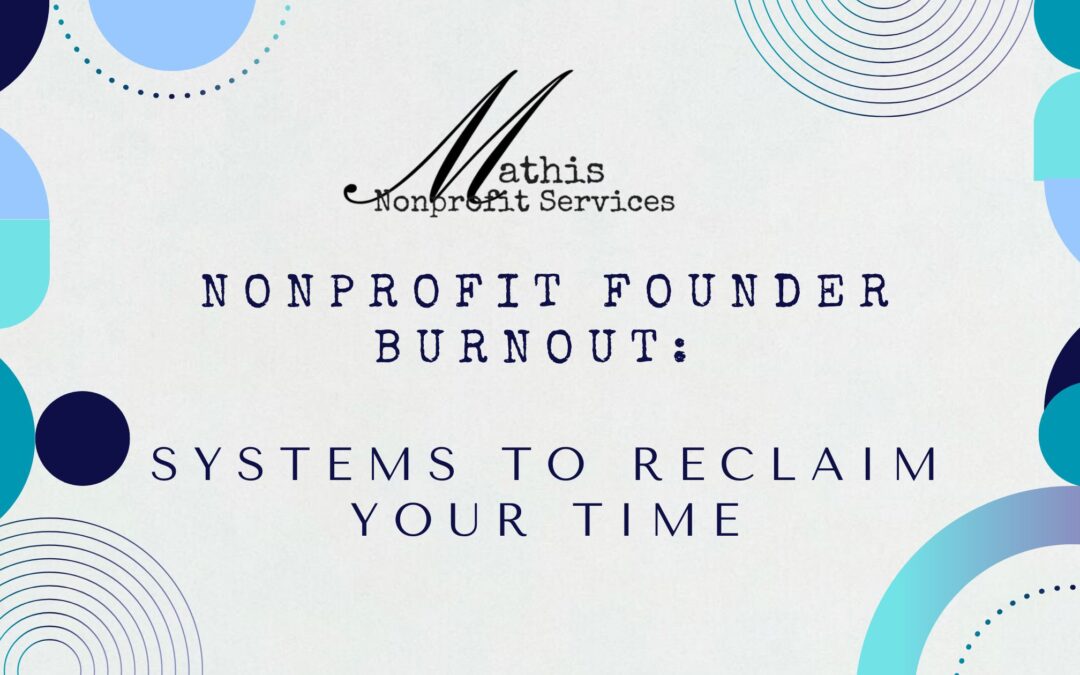
Key Highlights
- See how nonprofit burnout can quietly bring down the health and work of nonprofit leaders and the groups they are in.
- Look at early warning signs of burnout and take steps now to deal with how it can hurt nonprofit employees.
- Think about the systems you use and see them as ways to keep going strong, helping nonprofit professionals lower stress and set up a healthier work environment.
- Try out things like giving out tasks and helping leaders grow, so you take some pressure off your workload in a good way.
- Get clear ways to build strong inside systems, use your time well, and help bring lasting positive impact to the nonprofit sector.
Introduction
Do you ever feel like your nonprofit will fall apart if you take a day off? You are not the only one. The nonprofit sector is full of people who work hard and have a deep passion for what they do. The dedication seen in nonprofit leaders can lead to burnout. Burnout is a hidden problem and it can be hard on mental health. If you are in this field, you know that caring for others can take a toll on you. Building better work systems is not about strict rules. It is about reclaiming time, finding a bit of breathing space, and keeping the positive impact of your nonprofit going strong, without costing you personally. Now, let’s find out how to do this together.
The Hidden Cost of Leading a Nonprofit: Founder Burnout in America
Running a nonprofit organisation is a good thing, but working long hours every day with limited resources can cause burnout in nonprofit leaders. This kind of stress can hurt their mental health and also put their goals at risk. Many people do not see how hard this is, but it is a big problem for those in the nonprofit world.
Nonprofit professionals work hard and often bounce back from tough times, but the need to always get money and the deep care they have for their work challenge them, too. Burnout is real for nonprofit founders and other leaders, including the CEO, in the nonprofit world, and it is something that needs attention now. Seeing the effect it has is the first step to helping. Doing this can make leadership and the whole organization stronger and better for everyone.
Why Nonprofit Founders Are More Vulnerable to Burnout
Nonprofit founders deal with unique challenges every day that make them more likely to get burnout. They have to put on many hats and switch often between tasks, leading to high levels of stress. They do things like manage paperwork, run their programs, and find enough resources. With so much to do and not enough help, the pressure builds up. These nonprofit leaders are pulled in many ways, and they are expected to do a lot. This leaves little time for rest or taking care of themselves.
There is also the extra weight from the emotional part of the job. A nonprofit executive faces tough problems, like human suffering. This stress keeps building. In these types of jobs, you see more deep and tough issues than in most companies. All these problems are not easy. This adds extra stress and can be hard on the mental health of nonprofit leaders.
If nonprofit professionals do not have good support or strong systems in place, they can’t pass off work to others. This means their load gets even heavier. This problem gets worse when founders feel they must take care of everything in the nonprofit on their own. It is important to know about these unique challenges. When people are aware, they can find ways to help, so nonprofit leaders do not get burnout. This way, support is given, and mental health does not suffer.
The Reality of Wearing Every Hat
Being an executive director in a nonprofit organisation is not easy. As a founder, you may have to do many different jobs. You may be a fundraiser, a marketer, and a planner all at once. This kind of hard work can feel never-ending, and it can be hard to take time for yourself or to let someone else help.
A big reason for this is the limited resources in the nonprofit workplace. Nonprofit organizations often have less money and fewer staff. Because of this, nonprofit employees and nonprofit professionals work long hours and do more than one job at a time. All this extra workload can cause exhaustion and stress over time.
If you don’t have any good systems or ways to let others help, burnout can happen fast in nonprofit leaders. This makes the group’s mission harder to reach. It is easy to feel like everything about your nonprofit will fall apart if you do not give all your effort, but this is not a good or safe way to work. You need to set up systems, learn to give some jobs to others, and set strong limits. By doing this, nonprofit leaders can focus better on what matters most, and still protect their own health.
Early Warning Signs You’re Heading Toward Burnout

Burnout does not start all at once. It shows up through small warning signs that many nonprofit employees do not notice. If you feel like you always “have to be on call” in the nonprofit sector, that can be the first sign that burnout may happen to you.
Some signs include always feeling tired, doing less work than usual, and having emotional detachment. Nonprofit leaders who spot these warning signs early can help their staff before burnout sets in. The best thing to do is focus on work-life balance and mental health. This will help the nonprofit sector keep going strong, and stop both founders and teams from feeling used up along the way.
Physical, Emotional, and Behavioral Red Flags
Spotting early warning signs is very important for nonprofit professionals. Burnout often shows up as physical symptoms such as feeling tired all the time, muscle pain, headaches, or stomach problems. If you ignore tiredness, it can turn into bigger mental health challenges later on.
When it comes to emotions, nonprofit burnout can bring feelings like being helpless or feeling removed from your cause. You may have a lack of motivation, feel more upset than usual, or think things will not get better. These common signs can hurt your personal life and cause problems at work.
In your actions, burnout may make you put off tasks, skip things that help you take care of yourself, or avoid what you should be doing. Others at work might start to see that you do not care as much. If nonprofit leaders notice these signs early and take a planned approach, they can help lower the risk of burnout in their work environment.
| Physical Symptoms | Emotional Indicators | Behavioral Signs |
|---|---|---|
| Chronic Exhaustion | Helplessness/Detachment | Procrastination/Difficulty |
| Headaches/Muscle Tension | Cynicism/Negativity | Neglect Self-Care |
How Reactivity Replaces Proactivity
Nonprofit leaders often face a lot of pressure. In a busy nonprofit workplace, nonprofit employees have too much to do. This makes them handle whatever comes up right away, instead of planning ahead. Because of this, stress builds up.
With this way of working, detachment can grow. People do not focus on long-term planning anymore. Now, they only think about getting through each day. Dedication turns into always needing to put out fires. Over time, everyone loses enthusiasm for the mission. Open communication within teams slows down. These mental health challenges can make burnout even worse for nonprofit professionals.
To solve this, leaders need to take back control. They can use good systems or delegate tasks more. This helps them step out of simple reaction and gives them space to create better ways of working. When preventive leadership is used, it supports nonprofit employees and motivates people. The work environment becomes healthy and builds real sustainability. This helps protect mental health and brings back open communication, dedication, and excitement to all in the nonprofit workplace.
Rethinking Systems: What They Are—and Aren’t
Systems in the nonprofit world are not here to bring in a bunch of strict rules. Instead, they help build networks that support nonprofit leaders and keep them from burning out.
These systems do not take away the flexibility or passion of the people who work there. They help people find a good balance between work and personal life. With the right systems, nonprofit professionals can use their energy on the work that is most important. This also helps a nonprofit organisation keep going and stay strong over the years. Now, let’s look at how good systems can help bring new energy to nonprofit workplaces.
Busting Myths: Systems Aren’t Rigid Bureaucracy
Many people think that using internal systems at work can make things feel strict or too set in stone. Some nonprofit leaders worry that having rules might make the nonprofit workplace less creative or flexible.
But good systems do not make things harder. They help with daily tasks and be sure things get done right. If you are a nonprofit executive who feels burnt out, having these frameworks can help you to be more adaptable and still care deeply about your cause. These systems can make your mind clearer by making things easy or automatic.
These tools do not copy rules from big companies. Good systems made for nonprofit organizations help you do your mission better. Make frameworks that have open communication with teams, let your people feel strong, and give everyone space to do their work well.
The Freedom and Flexibility That Good Systems Create
Effective systems help nonprofit leaders have more freedom. These systems are made to help, not take away from, your hard work. Think about it. You could take a day off, and your nonprofit workplace would still run well. This is the positive impact that comes from good systems.
When you make workload easier to handle, people in the group can give time to what matters most. It gets easier to trust and give out tasks when you know the systems keep things on track. This helps you save your personal time and energy.
Platforms that use simple things like automation and scheduling help nonprofit professionals stay fast and ready. But these tools do not make you feel weighed down. If you set up systems well, they can help you and your team meet big goals in a way that lasts.
Setting Up Weekly Planning to Protect Your Energy

Weekly planning is one good way for nonprofit executives to make their work life better. It is helpful because you get to guard your own personal time and still work on what the organization needs.
When you plan like this, you can stay ahead and not let chaos take over, which many nonprofit employees know too well. As a leader, you get to work in a more planned way. Tools and templates make it easy to pick what’s most important. These things help nonprofit professionals find time for self-care, while also staying on track with each mission step that leads to positive impact. Here is how these small routines can help your week at work.
Design a Routine That Safeguards Your Time
Creating a weekly plan on purpose can help nonprofit leaders handle their work better. Setting clear times for important tasks makes it easier to focus and gives less chance for emergencies to take over.
Start by setting clear limits between work time and personal life. Give each task a set time, and you will make fewer choices while things are busy at a nonprofit job. When nonprofit employees know what to expect each day and keep their commitments simple, they feel less stress.
Good routines help nonprofit leaders and nonprofit employees avoid burnout. They also make the work space healthier and keep everyone working toward the main mission without running into too much exhaustion.
Tools and Templates to Streamline Your Week
For nonprofit professionals who have busy schedules, using the right tools and templates can make tasks easier and help you have less exhaustion. Digital automation platforms are very helpful in nonprofit organisations. They send reminders and help manage workloads in a good way.
Popular solutions include:
- Google Calendar: This is helpful to automate your personal plans and your team’s plans together.
- Project Management Apps: Platforms like Trello help everyone in the team see and keep up with deadlines that help achieve your mission.
- Financial Reporting Templates: These templates make it easy to do the basic math for grants, so you do not have to repeat the same steps every time.
- Feedback Forms: These forms help nonprofit team members grow in their roles and move toward leadership.
- Attendance Trackers: These tools help keep events and sessions running on time. This stops poorly organised meetings that can lead to distraction.
Using templates can help automate jobs that nonprofit executive directors want to do with little effort or fewer steps.
The remaining H Tags will be constructed like the first half
Identifying Your “Founder-Only” Tasks vs. Delegatable Work
Knowing the difference between tasks that only you can do as the leader of a nonprofit and tasks that your team members can do is important. When you find out what jobs are “founder-only,” for example building important relationships and setting the vision for your nonprofit organization, you get more time to focus on things that have the most impact. If you give out other jobs, like paperwork or talking to people outside the group, your team members can help in a real way. When you make this change, you build a healthier work environment. This also lowers stress and lets people around you take charge. By doing this, you help your nonprofit organization to be stronger and better in the long run.
The Art of Letting Go: Delegation Without Guilt
Giving tasks to your team can help build a healthier work environment. When nonprofit leaders start to let go and delegate, it takes away some of the stress of all the jobs they have to do. At the same time, team members get the chance to be part of the work and show their dedication. It is important to know that your own strong passion for the cause does not mean you have to do everything on your own. Making this change helps the group work better. It can also stop or lessen signs of burnout. By doing this, you create a place where people work together and support one another.
Training Your Team (or Volunteers) to Take Ownership
Empowering your team members or volunteers to take charge helps them feel more responsible and committed. When you set clear expectations and help with open communication, you make a work environment where everyone is valued. Using leadership development programs can make their skills better and help them make good choices. This lets nonprofit leaders feel less pressure and helps everyone in the nonprofit sector grow a culture of adaptability and fulfillment. If your team is motivated, they can handle unique challenges better. This leads to a bigger impact for all of us.
Building Sustainable Internal Systems for the Long Haul
Making strong systems inside a nonprofit organization is important to help the group do well, especially with the unique challenges in the nonprofit sector. When you keep your work environment simple and easy to manage, it helps make it a healthier work environment for everyone. This can help nonprofit leaders and other people in the group feel less burned out.
If you make all your steps clear and keep proper notes, it can help your team members avoid getting tired from making too many decisions. Good records let team members feel they can take control of their work. Using new technology also helps. It can do the small, repeated jobs for you, so your team can focus on bigger things that matter.
All of this helps give team members more time for what is important, and at the same time, it puts mental health and a good work-life balance first.
Documenting Processes to Reduce Decision Fatigue
Making things run smoother by having clear documentation helps to create a healthier work environment in the nonprofit sector. When nonprofit leaders set out clear steps for every task, it takes away the stress of making too many decisions. This helps team members do better work each day. With simple step-by-step guides, team members know what to do. They can handle jobs on their own, so the executive director or founder does not have to do it all. This kind of planning helps everyone be more adaptable. It also has a positive impact on mental health. People feel part of the team, make a difference, and still have time for their own lives.
Using Technology to Automate and Simplify
Using technology in the nonprofit sector can change the way that work gets done. It can help make things smoother and lower the workload for nonprofit leaders and their teams. With the right tools, the group has less paperwork and day-to-day stress. This helps everyone enjoy a healthier work environment.
Automation can also help keep open communication for all the team members. People can spend more time on jobs that really matter instead of repeating the same tasks. If you work for a nonprofit, using new tech tools can boost how much work your team gets done and lift spirits at the same time. It helps to build a good and supportive culture, so the work environment is healthier. This can help mental health and cut down on burnout in your group.
Conclusion
Creating a healthier work environment in the nonprofit sector helps ease the stress that many nonprofit leaders face. When you know the unique challenges of nonprofit work, you can better manage both your workload and your mental health. Focus on open communication, delegation, and building systems that last. This helps team members grow and adapt to changes. By making self-care and mental health support a top priority, nonprofit professionals can stop burnout before it starts. This means their deep passion for a positive impact will stay strong over time.
Frequently Asked Questions
How can I start building systems with a tiny or solo team?
Start by finding the main steps that help to make work smoother. Try to make each task easy to do and write down how things should be done. Use tools and technology when you can for things like automation. Get your team to help build these systems. This will help everyone feel part of the process and will make sure it keeps working, even if you have limited resources.
What if my nonprofit is too small for delegation?
Even small nonprofits can get a lot from giving tasks to others. Begin by finding easy jobs that you can give to volunteers or part-time staff. Doing this lets you have more time for other work. It also helps your team feel like they are a real part of things and work well together. This way, everyone can get more done.
How do I prioritize what systems to create first?
To decide which systems you should make first, look at where your nonprofit has the biggest problems. Choose the areas that cause the most trouble and slow things down. Make a plan for these, so you can fix what matters most right away. This will free up your time and help you give work to other people on your team. By doing this, you will help everyone work better together and get things done in a good way.
Will systems make my nonprofit feel less mission-driven?
Putting good systems in place at your nonprofit can make things work better. It does not take away from what your group wants to do. When you make tasks simple and give jobs to the right people, you save time and energy. Then, you can use that time to work on your main goals. It also helps your team focus on what matters most and keep the group’s biggest aims in sight.
How can the Society Membership help me reduce burnout?
Being a member of a society gives you the chance to use helpful tools and meet others who understand nonprofit leadership. This can really help people who be under a lot of stress at work. When you join in, you start to connect with people like you. You also get to share tools and ways of working. With this help, you can share the tasks with others and let them take on some of the work. This makes it easier to handle everything and can help you feel less burnout.


 Most nonprofit leaders lay awake at night trying to figure out how to fund their mission.
Hi! I'm Alesha.
I teach sustainable fundraising in a way that they can take action today so they can serve their clients.
I can help you move from just getting started funding your new nonprofit to gaining confidence in your fundraising and building relationships to knowing what works for your organization and looking at the infinite game when it comes to funding. I’ve worked with nonprofit Founders and written the book I HAVE MY 501(C)3! NOW WHAT?!? Your Blueprint to Starting Your Nonprofit Without Being the Sole Funder that lays the foundations for funding in a new nonprofit.
I’ve worked in Development (Fundraising) Departments in large organizations and I know the no cost, low-cost methods they use to bring in funding. I bring those sound strategies to the nonprofits I serve.
Most nonprofit leaders lay awake at night trying to figure out how to fund their mission.
Hi! I'm Alesha.
I teach sustainable fundraising in a way that they can take action today so they can serve their clients.
I can help you move from just getting started funding your new nonprofit to gaining confidence in your fundraising and building relationships to knowing what works for your organization and looking at the infinite game when it comes to funding. I’ve worked with nonprofit Founders and written the book I HAVE MY 501(C)3! NOW WHAT?!? Your Blueprint to Starting Your Nonprofit Without Being the Sole Funder that lays the foundations for funding in a new nonprofit.
I’ve worked in Development (Fundraising) Departments in large organizations and I know the no cost, low-cost methods they use to bring in funding. I bring those sound strategies to the nonprofits I serve.